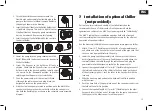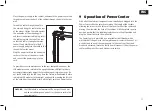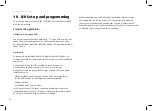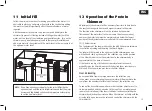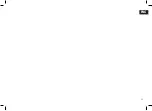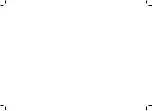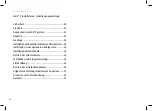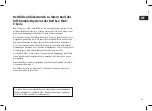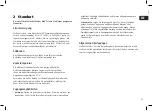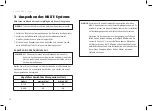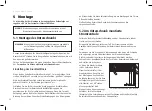
Red Sea MAX
®
E-Series
20
New Skimmers or Set-ups
Skimmers only produce foam if the
water contains the proteins that bind
to the surface of the air bubbles and
give the bubbles the structural rigidity
they need to ascend the neck of the
skimmer and settle in the collection
cup. In a new aquarium set-up the bio-
load is low and the amount of proteins
is negligible.
New skimmers sometimes need a short break-in period of a few days
before they begin to function efficiently. Over-skimming is common
while harmless chemical residues that affect the surface tension of the
water are neutralized.
Feeding and Supplementing
Skimmers are very susceptible to the effect of surface active compounds
such as foods and supplements that are added regularly to the aquarium.
Such materials can significantly affect the foam production and in some
cases cause over-skimming. Immediately before adding such materials
switch the skimmer off and leave off for 30 minutes or however long it
takes until the skimmer will return to its normal foaming action without
repositioning the Skim Adjuster.
Collection Cup
Monitor the amount of skimmate that accumulates in the collection cup
and empty the cup on a regular basis. When emptying the cup, clean the
inside of the neck by rinsing it with water, as the build-up of skimmate in
the neck will adversely affect the skimmer performance. If you wash the
cup with detergent make sure to rinse it thoroughly before returning it to
the skimmer.
13 General Aquarium
Maintenance
The long-term success and health of the inhabitants of your MAX
®
aquarium depends on you. Proper planning makes reef care easier to
manage and quicker to perform. This will leave you more time for the
real goal: enjoying your aquarium. Care of the tank should follow a
regular, logical pattern. Divide the tasks into daily, weekly and monthly
procedures, including equipment checks, feeding, water parameter
testing and adjustments.
You may find it helpful to make a systematic checklist of care activities
and keep a log of the activities performed. Your log does not need to be
complicated; you will need to track the following:
• The tank’s parameters – pH, salinity, temperature, etc.
• The general appearance of the tank and individual species.
• Equipment changes – when you changed light tubes or replaced
heaters, etc.
• Replacement of carbon or other filter media.
• Information specific to each animal – when they were added, moved
or removed, their approximate size, any signs of stress or ill health etc.
Water levels
Check the water level in the rear chamber on a daily basis and add fresh
water as required to compensate for any evaporation. Do not allow the
water level in the sump to remain outside of the min/max water levels.
If the water in the aquarium is too high check that the combs of the
surface skimmer are not blocked.
Surface Skimmer
Remove and clean the combs of the surface skimmer at least once a
Summary of Contents for MAX E Series
Page 2: ......
Page 3: ...ENG DE FR JP CHN 2 24 28 51 54 77 80 102 106 126...
Page 4: ......
Page 29: ...25 ENG...
Page 30: ......
Page 56: ......
Page 82: ......
Page 83: ...79 ENG DE FR JP 79...
Page 85: ...81 ENG DE FR JP 81 3 ENG...
Page 86: ...Red Sea MAX E Series 82 82...
Page 87: ...83 ENG DE FR JP 83 5 ENG...
Page 88: ...Red Sea MAX E Series 84 84 Red Sea MAX E Series 6 E 170 25 55 E 260 40 90...
Page 89: ...85 ENG DE FR JP 85...
Page 90: ...Red Sea MAX E Series 86 86 Red Sea MAX E Series 8...
Page 91: ...87 ENG DE FR JP 87 9 ENG 1 2...
Page 93: ...89 ENG DE FR JP 89 11 ENG 10 11 1 9 9 6 6 8 2 3 4 4 7 7 5 5 12 13...
Page 94: ...Red Sea MAX E Series 90 90 Red Sea MAX E Series 12...
Page 95: ...91 ENG DE FR JP 91...
Page 96: ...Red Sea MAX E Series 92 92 Red Sea MAX E Series 14...
Page 97: ...93 ENG DE FR JP 93...
Page 98: ...Red Sea MAX E Series 94 94 Red Sea MAX E Series 16...
Page 99: ...95 ENG DE FR JP 95 17...
Page 100: ...Red Sea MAX E Series 96 96 Red Sea MAX E Series 18...
Page 101: ...97 ENG DE FR JP 97...
Page 102: ...Red Sea MAX E Series 98 98 Red Sea MAX E Series 20...
Page 103: ...99 ENG DE FR JP 99...
Page 104: ...Red Sea MAX E Series 100 100 Red Sea MAX E Series 22...
Page 105: ...101 ENG DE FR JP 101 23 ENG...
Page 106: ...Red Sea MAX E Series 102 102 Red Sea MAX E Series 24...
Page 107: ...103 ENG DE FR JP 103...
Page 108: ......
Page 109: ...105 ENG CHN MAX E...
Page 111: ...107 ENG CHN MAX E MAX MAX MAX E MAX MAX redseafish cn...
Page 112: ...Red Sea MAX E Series 108 1 1 1...
Page 114: ...Red Sea MAX E Series 110 3 MAX E 1 2 3 MAX E 2 5cm 1 15 kg lb E 170 25 55 E 260 40 90...
Page 117: ...113 ENG CHN 5 3 LED 5 4 LED LED LED 5 5 2 86cm 34 1 2...
Page 119: ...115 ENG CHN E 260 10 11 1 9 9 6 6 8 2 3 4 4 7 7 5 5 12 13...
Page 121: ...117 ENG CHN c d 1 2 3 4 12 122 5 6 6 2 6 3 6 4 24 72 6 5 6 6 MSK 900 c d...
Page 122: ...Red Sea MAX E Series 118 6 7 1 2 3 4 5 6 7 8...
Page 123: ...119 ENG CHN 7 MAX E MAX E 1 17mm 30cm 4 2 3 17mm 4 5 6 17mm 7 8 pH 8 LED M3 LED LED 5...
Page 124: ...Red Sea MAX E Series 120 LED LED LED LED DC 9 LED...
Page 125: ...121 ENG CHN 10 LED ReefLED 90 8 12 9 4 LED 8 20 4 5 11...
Page 126: ...Red Sea MAX E Series 122 12 MSK 30...
Page 127: ...123 ENG CHN 13 MAX pH...
Page 128: ...Red Sea MAX E Series 124 24 28 C 76 82 F 2 C 7 F 14 Q A Q A Q A MAX Q A 12 122...
Page 129: ...125 ENG CHN Q A Q A Q A MAX E 24...
Page 131: ......










